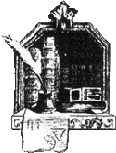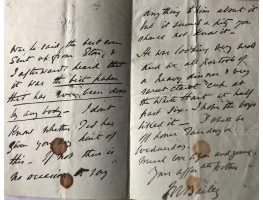1919 Order for Unveiling of Memorial to 18 little children killed during Enemy Air Raid, June 1917; Hand-bill for 1926 lecture by Ashmore on Anti-Aircraft Defence; 100pp.
Major-General Ashmore fought in the Boer War with the Royal Artillery. Before the First World War he learnt to fly and joined the Royal Flying Corps. In August 1917, he was appointed Commander of London Air Defence Area. Ashmore set up observation positions from London to the Channel coast, to give early warnings of raids. A system of anti-aircraft weapons, barrage balloons, aerial nets, and searchlights were in operation once German aircraft were overland. During the 1920s, he continued to consider how best to defend air attacks, and had a prominent role in setting up the Royal Observer Corps. In 1929, on retirement, he published 'Air Defence'. It is thanks to his work that air defences were in place for the Second World War, when he joined the Home Guard. See, SIMPSON, GEOFF 'Edward Ashmore and the Defence of Britain'.
1919 Order for Unveiling of Memorial to 18 little children killed during Enemy Air Raid, June 1917; Hand-bill for 1926 lecture by Ashmore on Anti-Aircraft Defence; 100pp.
Major-General Ashmore fought in the Boer War with the Royal Artillery. Before the First World War he learnt to fly and joined the Royal Flying Corps. In August 1917, he was appointed Commander of London Air Defence Area. Ashmore set up observation positions from London to the Channel coast, to give early warnings of raids. A system of anti-aircraft weapons, barrage balloons, aerial nets, and searchlights were in operation once German aircraft were overland. During the 1920s, he continued to consider how best to defend air attacks, and had a prominent role in setting up the Royal Observer Corps. In 1929, on retirement, he published 'Air Defence'. It is thanks to his work that air defences were in place for the Second World War, when he joined the Home Guard. See, SIMPSON, GEOFF 'Edward Ashmore and the Defence of Britain'.
| Binding | Folio (12 x 10in) blue cloth, |
| Publication | 1917-1936. Loosely inserted, letter informing him he passed entrance exam to Royal Military Academy, 1889, with a letter attached, from his uncle to his mother, saying his tutor at Eton informed him 'it was the best [mathematical] paper that has ever been done by any body'.; 5pp, MANUSCRIPT review in ink, of J.M. Spaight's 'Air Power and the Cities' [1930] |
- Product Code: RGW25861
- Availability: In Stock
-
£200.00

